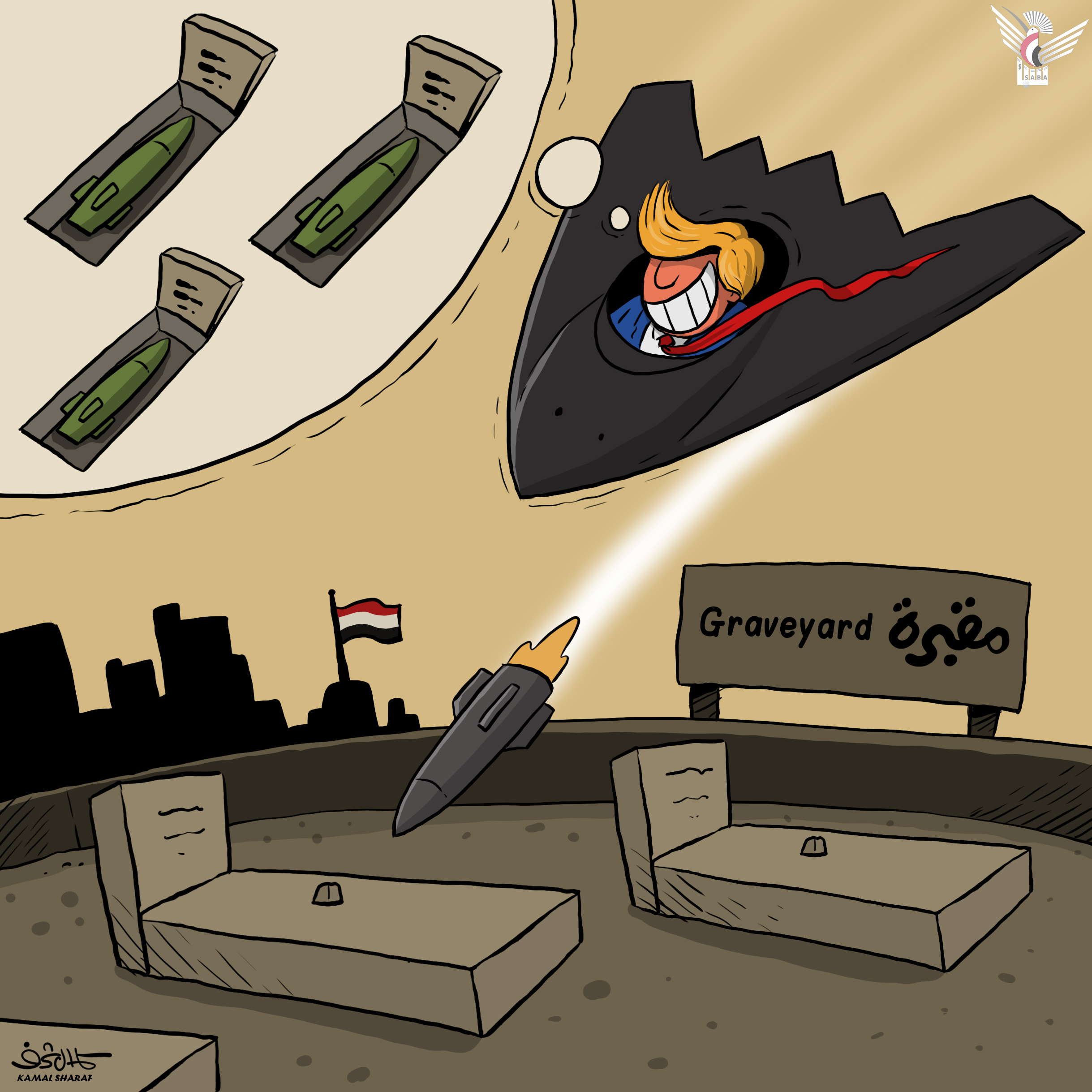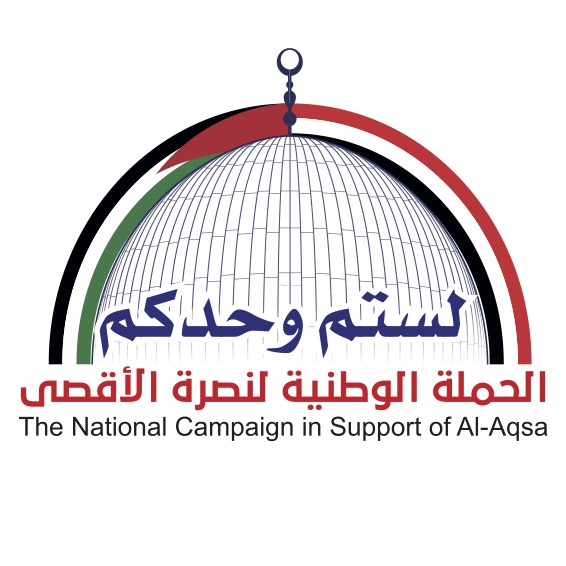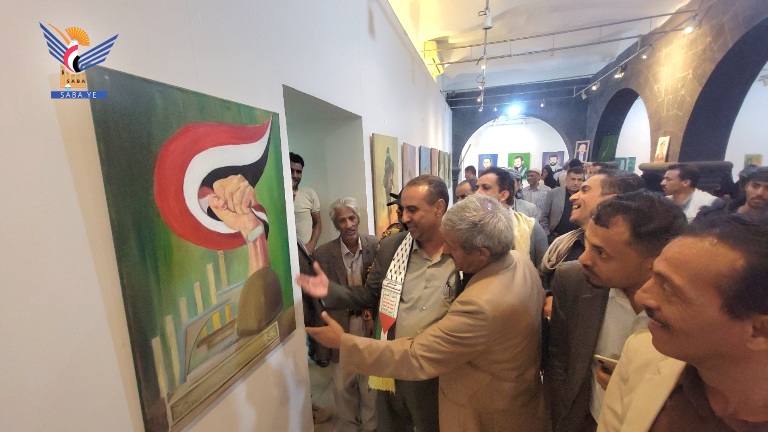Sana'a-Saba: Visitors to the "Art, Steadfastness and Victories" exhibition, currently being held at the Sana'a Gallery, can barely hear anything but the rising sounds of the revolution and the roar of popular anger rising as a result of the continuation of the most heinous crimes of genocide in human history by the herds of the occupation and the Zionist-American enemy in Gaza and Lebanon.
As soon as the visitor enters the wooden gate of the gallery, from the northern side overlooking Tahrir Square, in the heart of the capital Sana'a, those sounds begin to attract him and take him away from the sounds and events taking place outside.
The paintings begin to greet the visitor at the glass entrance of the gallery with its attractive traditional architectural style, bearing portraits of symbols and flags of the leaders of the resistance axis, and its heroic martyrs, who sacrificed their lives to defend the nation and its just fateful causes, and on the path to Al-Quds and Palestine.
Among the most prominent of these great martyrs, each of whom carried a unique story of struggle and heroism, are the martyr leader Sayyed Hussein Badr al-Din al-Houthi, the martyr President Saleh al-Samad, the head of the political bureau of the Hamas movement, the martyr Ismail Haniyeh, the martyr Secretary-General of Hezbollah, Sayyed Hassan Nasrallah, the commander of the Quds Force, the martyr Qassem Soleimani, and a group of martyrs.
Among the images of the leaders of the resistance, the image of the leader of the revolution, Sayyed Abdul-Malik Badr al-Din al-Houthi, carries with it many connotations and symbolism, and confirms his leadership of the scene today as the most important figure who bears the responsibility of leading the resistance axis against the axis of evil and Zionist-American aggression.
The visitor then moves, through a series of eventful paintings, to the noise of weapons and the whizzing of bullets, and oil paintings depicting the men and heroes of Yemen, wearing their weapons in the fields of honor and heroism, and teaching the invaders and aggressors over the past years, lessons in pride, honor, dignity, defending the land and honor, and victory for national sovereignty.
The paintings do not only embody what Yemen has witnessed in terms of Saudi-American aggression and the ongoing siege for the tenth year, and the total suffering it has caused for citizens in various directions and levels, but they also link all of that to the major events that the region is witnessing in terms of the greatest and most sacred revolution in modern and contemporary history, which the countries of the axis of resistance and their peoples are experiencing, in the face of the forces of injustice and global arrogance and their agents and mercenaries in the shadow of shameful Arab and international silence and collusion.
In the middle of the exhibition hall, which recently opened its doors to hold exhibitions after a hiatus of several years, in a message that art and the brush have a voice that must not be silenced in this difficult stage in the history of the nation; the visitor stops in front of a fair number of oil paintings that depict the unity of the suffering experienced by the peoples today in Gaza, Iraq, Syria, Lebanon and Yemen.
The roar of the aggression forces' aircraft and their treacherous raids, targeting innocent civilians and their repercussions of destruction, killing, displacement and suffering, rises, and that sound echoes in the ears of visitors, in the form of resounding screams emanating from the throats of helpless mothers and children, calling for help from a deaf world that is completely unable to stop the massacres and stand by the right and its people.
In the hall's corridors, which consist of rooms and attached basements equipped with colored lights directed at the canvas paintings connected in an aesthetic style to the walls, plaster and stone, through nylon threads, the sounds of the peaceful demonstrations and marches that preceded the immortal September 21 Revolution, and the events that followed, leak out to indicate the importance of the revolution, its timing and how it came to correct the course of the Yemeni revolutions as a whole and achieve many of its goals, the most important of which is building a strong national army and liberation from dependence and guardianship.
The visitor also sees, among the many connotations of the paintings, the features of the heroisms written by the armies and peoples of the axis of resistance countries, and their military, political and media achievements, in the face of the aggression machine, despite its military and media enormity, so that the visitor finds himself in front of paintings that expose and expose all that falsehood and pretense of the aggression and of Western society and its mercenaries towards many issues related to human rights, women and children, and the alleged Western moral superiority.
Amidst the mix of cannons, demonstrations, anger, revolution, and the repercussions of the genocidal war against civilians in Gaza and Lebanon, another painting embodies steadfastness in its brightest form with a painting of a child clinging to life despite being surrounded by blood, death, and its tools from every direction.
While sounds of hope and optimism emanate from among the paintings, depicting him in the form of a glowing light appearing at the end of the dark tunnel, in one of the paintings, in a message that confirms the fact that the victory of truth over falsehood is inevitable.
Through more than 100 paintings by 35 professional and talented artists, it becomes clear to the visitor that the hall is filled with paintings inhabited by oppressed men, women and children, and seems like a fictional biography or an indictment that falls within the literature of the moral downfall of the hypocritical world, exposing the entire international community, which hides behind its pretense of ignoring and turning a blind eye to what is happening in Gaza and Lebanon and its claim to understand, its ignorance, subservience and fear of America and its fall into the swamp of the crisis of the lack of human conscience.
M.M

| more of (Reports) |




